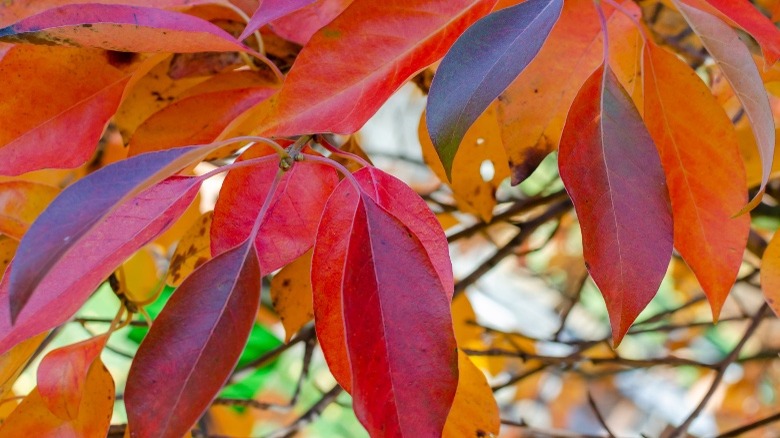The Tree To Select For Your Damp Yard If You Love Vibrant Fall Foliage
If you're looking for a tree with brilliant fall foliage to brighten your yard, look no further than the black tupelo (Nyssa sylvatica). Fiery reds, oranges, vivid yellows, and even purple shades (often all at once) make the black tupelo a leaf-peeper's favorite. When it isn't showing off its autumnal finery, it has gorgeous, deep green, glossy leaves. The black tupelo's bark is another standout feature, resembling alligator skin. This stunning tree can be oval or have the pyramid shape of a Bradford pear (Pyrus calleryana), a tree you should avoid. Unlike the Bradford pear, black tupelo is non-invasive as it is native to North America.
The black tupelo does well in wet soil, making it an ideal choice for yards that suffer from poor drainage. Besides being easy to grow with some of the showiest fall foliage, the black tupelo is valuable to birds and other wildlife. The tree produces a small fruit, which attracts many species of birds, and the flowers attract pollinators like bees, providing a much-needed food source. The black tupelo can grow up to 40 to 70 feet tall, but it is slow-growing. After 10 years, the average tree will be about 15 feet tall. If you need a fast-growing tree for your yard, there are others that reach maturity much quicker.
How to care for a black tupelo
The black tupelo is a low-maintenance tree that needs very little care once you've established it in the right growing conditions. When choosing a home for your tree, be sure to place it in a sunny spot, as it thrives in full sun but can tolerate partial shade. Six hours of full sun per day is the recommended amount needed. Even though they are slow growers, they will be big trees, so be sure to allow at least 20 feet between a black tupelo and other trees. You can encourage impressive fall colors by taking a few steps to ensure your tree stays healthy.
Moist, slightly acidic soil is preferred for a black tupelo to grow properly and produce spectacular foliage. Although it tolerates drought well, if you experience an especially dry summer, be sure to add daily soaking of your black tupelo to your gardening routine. Fertilizing it is a yearly process, using a slow-release fertilizer to encourage showy brilliant color each fall.
As with all routine tree care, you'll need to learn how to spot a diseased tree. While black tupelo trees are disease and pest-resistant, they can get cankers and leaf spots. Cankers are caused by fungi and result in dead branches and decaying bark, while leaf spots attack the leaves of the tree, causing premature leaf drop. You can control cankers by pruning infected branches, and prevent future leaf spots by clearing out infected leaves. If your tree continues to decline after taking these measures, reach out to an arborist for professional guidance.

